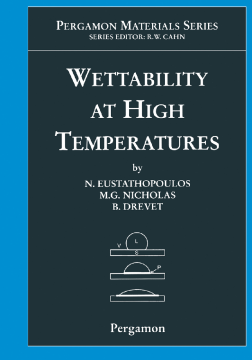
Additional Information
Book Details
Abstract
The purpose of this book is to bring together current scientific understanding of wetting behaviour that has been gained from theoretical models and quantitative experimental observations. The materials considered are liquid metals or inorganic glasses in contact with solid metals or ceramics at temperatures of 200-2000oC.
Wetting has been a significant scientific concern for the last two centuries and reference will be made to classical work by nineteenth century scientists such as Dupré, Laplace and Young that was validated by observations of the behaviour of chemically inert ambient temperature systems.
In attempting to achieve the aims of the book, the text has been divided into ten Chapters that can be grouped into four stages of presentation. The first stage comprises two Chapters that review established and newly developed models for their relevance to wetting behaviour at high temperatures, including recent models that encompass the role of chemical reactions at the solid/liquid interfaces. Attention is paid both to equilibrium wetting behaviour (Chapter 1) and to the factors that control the approach to equilibrium (Chapter 2). Then follow Chapters concerned with experimental techniques for scientific measurement of the extent of wetting (Chapter 3) and with the surface energy data for both metals and non-metals that are essential for quantitative interpretation of wetting behaviour (Chapter 4). Descriptions of experimentally determined and quantified wetting behaviour are presented and interpreted in the third part comprising five Chapters dealing with the characteristics of metal/metal, metal/oxide, metal/non-oxide, metal/carbon and molten glass/solid systems. The book concludes with a Chapter commenting on the role of wetting behaviour in joining similar and dissimilar materials by liquid route techniques.
Andreas Mortensen
Capillary equilibrium involving a liquid in contact with a solid is of nearly ubiquitous importance. In everyday life, in industry, in nature, liquid constantly meets solid and this encounter has numerous consequences. At elevated temperatures, the same holds true: metallic or ceramic liquids nearly always come at some point in contact with a solid, and this contact influences many important industrial processes. There are very basic difference between wetting at high temperature and wetting at more usual, near-ambient, temperatures: atoms move faster and atoms interact more strongly. For this reason, wetting at elevated temperature represents a specific problem, and it is pertinent that a book focus on this question.
"Wettability at High Temperatures" does so on the basis of a detailed exposition of underlying fundamentals, both theoretical and experimental. Indeed, the fact that at elevated temperature "everything reacts with everything" has particularly strong consequences in capillarity, because atomic species can, even at minute concentrations and with limited mobility, segregate and completely alter capillary equilibria. Coverage then dives in great detail into the specifics of the principal systems of interest, and then focusses on brazing, a process which relies nearly entirely on elevated temperature capillarity. In addition, this book provides a wealth of data, and as such represents not only a valuable introduction to the field, but a working tool for the practicing scientist and engineer.
The authors count among the top-most present contributors to this question. Dr. Nicholas is a well recognized expert of capillary phenomena in materials processing, and of the brazing process in particular. We owe to Drs. Drevet and Eustathopoulos much of what is the current state of advancement of basic research on wetting at elevated temperature, including the high standards that now exist in experimentation and the gradual establishment, on the basis of trustworthy experimental results, of a framework for analysis of the thermodynamics and the kinetics of wetting phenomena at elevated temperature. This is a field of research that is advancing rapidly, and one which is now yielding results and methodologies which can be exploited with confidence in engineering. This book will no doubt represent a milestone, both as a summary of where we now stand, but also as a driving force for future progress on this important question.
Swiss Federal Institute of Technology, Lausanne (EPFL), Switzerland
Antoni P. Tomsia
The book describes the unique nature of the high-temperature wetting
phenomena occurring at various material interfaces and explains the
phenomena in terms of such properties as surface and interfacial energy,
adhesion, and adsorption.
The book carefully delineates why and how the wetting of liquids
on solids is such a key aspect of many industrial processes. It illustrates,
for example, how joining dissimilar materials by soldering or brazing is critical
for interconnections and packaging in microelectronic and opto-electronic
devices, as well as for fabricating a wide range of structural
materials.
The book also shows the importance of fluid flow in fabricating
many strong, low-density composite materials, and how minor
compositional alterations can markedly affect not only rates of
infiltration or reaction, but even the outcome of such reactions.
This book should be a valuable reference for scientists working
in these areas. No treatment of high-temperature wetting phenomena has up to now
been undertaken. This clear and comprehensive study thus fills an
important need.
Lawrence Berkeley National Laboratory, Berkeley, USA
